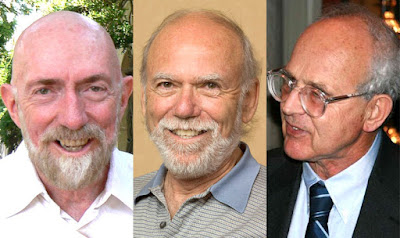Gravitational Waves Detected by LIGO
Founder = Barry C. Barish, Kip S. Thorne, and Rainer Weiss win the 2017 Nobel Prize in Physics.
Astronomers have directly detected elusive gravitational waves, 100 years after the existence of these spacetime ripples was first proposed by Albert Einstein in his theory of general relativity. The three-detector observation was made on August 14, 2017 at 10:30:43 UTC. The two Laser Interferometer Gravitational-Wave Observatory (LIGO) detectors, located in Livingston, Louisiana, and Hanford, Washington, and funded by the National Science Foundation (NSF), and the Virgo detector, located near Pisa, Italy, detected a transient gravitational-wave signal produced by the coalescence of two stellar mass black holes.
Advanced LIGO is a second-generation gravitational-wave detector consisting of the two identical interferometers in Hanford and Livingston, and uses precision laser interferometry to detect gravitational waves. Beginning operating in September 2015, Advanced LIGO has conducted two observing runs. The second “O2” observing run began on November 30, 2016 and ended on August 25, 2017.
LIGO and VIRGO’s partner electromagnetic facilities around the world didn’t identify a counterpart for GW170814, which was similar to the three prior LIGO observations of black hole mergers. Black holes produce gravitational waves but not light.
“With this first joint detection by the Advanced LIGO and Virgo detectors, we have taken one step further into the gravitational-wave cosmos,” says Caltech’s David H. Reitze, the executive director of the LIGO Laboratory. “Virgo brings a powerful new capability to detect and better locate gravitational-wave sources, one that will undoubtedly lead to exciting and unanticipated results in the future.”
Thanks And Share It And Follow Me


0 Comments
Post a Comment